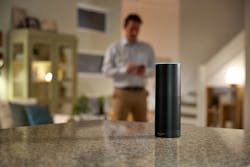Synaptics Introduces Chip That Can Better Grasp Voice Commands
Synaptics introduced its latest line of chips targeting electronic devices that can be controlled through a person’s voice, offering wake word spotting and far-field voice processing capabilities. The company said on Monday at the Consumer Electronics Show in Las Vegas that the 22-nanometer chips integrate custom silicon specifically for processing artificial intelligence algorithms.
The AudioSmart product line is designed to distinguish voices in louder environments and from longer distances than ever before. The chips are capable of improving barge-in capabilities during loud playback. The chips can also be programmed to respond to different wake words than the boilerplate “Hey, Google” or “Alexa.” They are compatible with voice assistants from Amazon, Google and Baidu, among others.
The embedded artificial intelligence engine is based on the company’s SyNAP technology, which enables electronic devices to run automated speech recognition, natural language understanding and other chores without sending voice commands to the cloud for processing. That means core voice control capabilities can work even when the device is only intermittently connected to the internet.
That also could potentially lower latency, allowing electronic devices to respond to voice commands faster than is currently possible, according to Synaptics. Handling artificial intelligence inside the device could also enhance privacy and security by curtailing the need to continuously send personal data to the cloud. Other advantages are the ability for devices to better learn user behavior and contextual awareness.
As Google Home, Amazon Alexa and other voice assistants are designed into more and more consumer devices, other companies are entering the space. Knowles, the largest supplier of silicon microphones, last year introduced a custom digital signal processor for grasping voice commands. The processor also sifts through background noise to amplify the volume and sharpen the clarity of a speaker’s voice.
Shipments of smart speakers increased almost 200 percent annually to 22.7 million units in the third quarter last year, according to market researcher Strategy Analytics. Some companies, including startup Vesper Technologies, which sells microphones that consume less power than normal, point to the current performance of far-field voice processing to explain why sales are not growing even faster.
“Intelligence at the edge begins in the smart home where privacy is paramount and with voice as the fastest growing and most natural human interface,” Huibert Verhoeven, vice president of the Internet of Things unit at Synaptics, said in a statement. Synaptics said that its latest chips can be used in thermostats, home appliances, lighting and other devices sold at “affordable consumer electronic” prices.
The first processor in the product line, the AS371, is currently sampling to potential customers. The three other AudioSmart chips—the AS390 for voice-enabled electronic devices with displays, the AS350 for lower power devices that can be controlled with voice commands, and the AS320 for voice-enabled devices based on microcontrollers—will be available in sample quantities in the first quarter this year.
About the Author
James Morra
Senior Editor
James Morra is the senior editor for Electronic Design, covering the semiconductor industry and new technology trends, with a focus on power electronics and power management. He also reports on the business behind electrical engineering, including the electronics supply chain. He joined Electronic Design in 2015 and is based in Chicago, Illinois.

